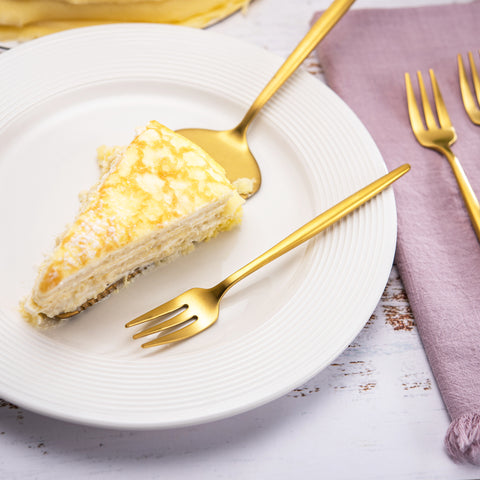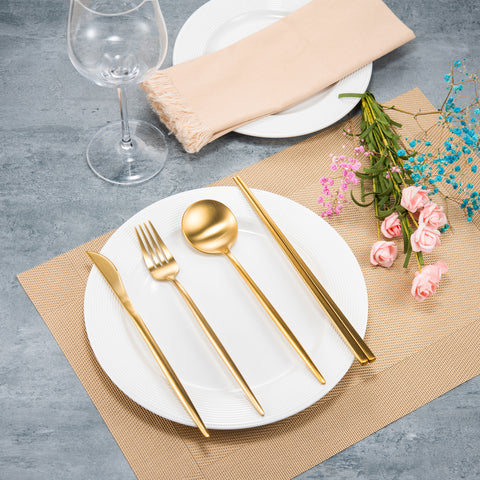"Why is my silverware turning black?" This common question often perplexes many homeowners who notice that their once-shiny, elegant silverware is gradually darkening.
The phenomenon is not uncommon and can be attributed to a variety of factors, including natural tarnishing, chemical reactions, and environmental influences. This exploration will explore the reasons behind this intriguing transformation and provide insights into how to prevent and remedy blackening silverware, preserving its lustrous appearance for years.
What Causes Silverware to Turn Black?
One of the most annoying and baffling things about silverware is when it turns black. Have you ever wondered why this happens and what causes it? Well, let us dive into the world of science and chemistry to uncover the secrets behind this mysterious phenomenon.
1. Oxidation:
When silverware is exposed to air, the silver atoms on the surface react with oxygen, forming a layer of silver oxide (Ag2O). This layer is black and gives the silverware a tarnished appearance. Oxidation is a slow and natural process, and it occurs even more rapidly in the presence of pollutants in the air, like sulfur compounds.
2. Sulfur Compounds:
Sulfur-containing compounds, such as hydrogen sulfide (H2S), are often present in the atmosphere and can be found in certain foods like eggs and onions. When silverware comes into contact with these compounds, a chemical reaction occurs. The silver atoms combine with the sulfur to form silver sulfide (Ag2S), a dark, black compound. This silver sulfide layer adheres to the silver surface, causing the silverware to tarnish.
3. Acids:
Acids, particularly those found in food, can react with the silver in silverware. Foods like vinegar, citrus fruits, and tomato-based products contain acids. When silverware comes into contact with these acidic substances, the acid can accelerate tarnishing. The acid can react with the silver, forming silver compounds that are often black or dark in color.
4. Moisture and Humidity:
Exposure to moisture and high humidity can lead to tarnishing of silverware. Moisture facilitates the chemical reactions on the silver's surface, which can result in the formation of black tarnish. It's important to keep silverware dry when not in use to prevent or slow down this process.
5. Contact with Other Metals:
When silverware comes into contact with other metals, particularly metals like stainless steel or aluminum, it can lead to galvanic corrosion. In this process, electrons are exchanged between the metals, causing corrosion on the surface of the silverware. This corrosion can result in a blackened appearance.
6. Sulfides in Storage:
Some materials used for storage, such as rubber bands, certain types of wool, or felt, release sulfur gases. When storing silverware in contact with these materials, it can accelerate tarnishing. The sulfur compounds released by these materials react with the silver to form silver sulfides, which are dark in color.
->> Visit KiiZYs Amazon page. All our Cutlery Giftware and matching Serveware are Lead free, Cadnium free and Phthalates free.
How to Remove Tarnish from Silverware
To remove tarnish from silverware, you can use various methods and cleaning solutions, both commercial and homemade. Here's a step-by-step guide on how to clean tarnished silverware:
Materials you may need:- Tarnished silverware
- Mild dishwashing detergent
- Warm water
- Soft cloths or sponges
- Silver polish (commercial or homemade)
- A soft-bristle toothbrush (optional)
- Baking soda (optional)
Steps:
-
Prepare a Cleaning Solution:
Fill a basin or sink with warm water. Add a few drops of mild dishwashing detergent and mix to create a soapy solution. This will help remove surface dirt and grime.
-
Soak the Silverware:
Place the tarnished silverware in the soapy water solution. Allow it to soak for a few minutes to loosen the tarnish and dirt.
-
Gentle Cleaning:
Use a soft cloth or sponge to clean the silverware gently. Be careful not to scrub too hard, as this can scratch the silver's surface. For intricate patterns or hard-to-reach areas, you can use a soft-bristle toothbrush.
-
Rinse Thoroughly:
Rinse the silverware with clean, warm water to remove any soap residue.
-
Polishing:
At this point, you can choose to use a commercial silver polish or a homemade solution.
Commercial Silver Polish: Follow the manufacturer's instructions on the silver polish container. Typically, you'll apply the polish to a soft cloth, rub it onto the silverware, and then buff it with a clean cloth until the tarnish is removed.
Homemade Silver Polish: If you prefer a homemade solution, create a paste using baking soda and a small amount of water. Apply the paste to the tarnished areas and gently rub with a soft cloth until the tarnish is removed.

-
Buff and Shine:
Once the tarnish is removed, use a clean, dry cloth to buff the silverware to a high shine. This step helps remove any remaining residue and brings out the silver's natural luster.
-
Final Rinse:
If you've used a commercial silver polish, it's a good idea to give the silverware a final rinse with warm water to remove all traces of the polish.
--> Check out our Amazon store : FDA Approved Stainless Steel Silverware Set
Alternative Solutions: Protecting silverware from tarnish
To protect silverware from tarnish, consider these alternative solutions:
- Anti-Tarnish Cloths: Store silverware in anti-tarnish cloths or pouches. These specially treated cloths absorb moisture and neutralize sulfur gases, preventing tarnish from forming.
- Silica Gel Packs: Place silica gel packs in your silverware storage. Silica gel helps absorb moisture, keeping the storage environment dry and preventing tarnish.
- Tarnish Strips: Use tarnish strips or tabs inside storage containers. These strips release chemicals that neutralize tarnish-causing gases, preserving the silverware's shine.
- Varnish or Lacquer: Consider applying a thin, clear varnish or lacquer coat to create a protective barrier on your silverware. However, this method is best for pieces that won’t be in direct contact with food.

Final Thoughts
In conclusion, there are several reasons why your silverware may be turning black. It could be due to tarnish caused by exposure to air and moisture, chemical reactions with certain foods or cleaning agents, or even the type of silverware material itself. To prevent this discoloration and maintain the shine of your silverware, it is important to clean and store them properly.
Regularly polish your silverware using appropriate methods and avoid harsh chemicals that can cause damage. Consider storing them in anti-tarnish bags or using silica gel packets to reduce exposure to moisture. By taking these preventive measures, you can enjoy the beauty and longevity of your silverware for years to come.
FAQs
What is the best quality stainless flatware?
The best quality stainless flatware is typically made from 18/10 stainless steel. This grade signifies the stainless steel's composition, with 18% chromium and 10% nickel, providing durability, rust resistance, and a polished appearance.
Can cleaning products cause silverware to turn black?
Some harsh cleaning products containing chemicals like bleach or ammonia can react with silver, causing it to tarnish and turn black.
Does the type of metal affect how quickly silverware turns black?
Yes, certain metals like sterling silver are more prone to tarnishing compared to stainless steel or other alloys. However, all types of silverware can potentially tarnish over time.

